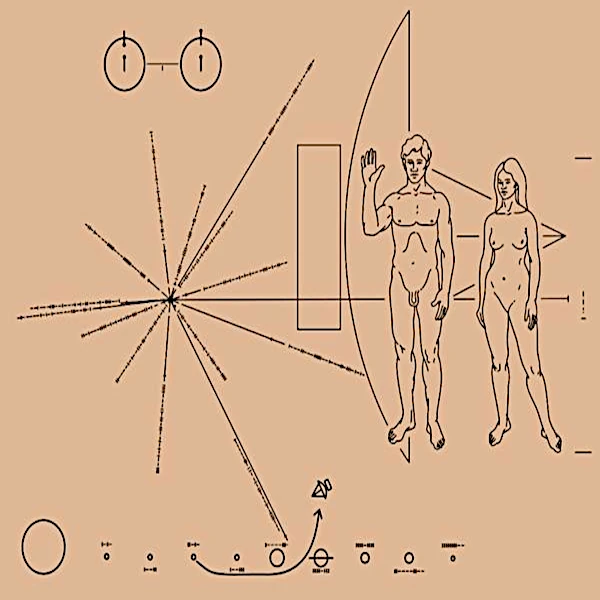
Image: Pioneer Probes 10 and 11 both carried small metal plaques identifying their time and place of origin for the benefit of any other space travelers who might find them in the distant future. The golden plaque is the brainchild of Carl Sagan who wanted any extraterrestrial civilization that might encounter the craft to know who made it and how to contact them.
Credit: NASA
The Pioneer probes marked the beginning of the United States (NASA) space age.
The first Pioneer 0 probe was launched on August 17, 1958. This probe was intended to orbit the Moon, but it exploded upon takeoff.
Between 1958 and 1978, 19 Pioneer probes were sent with different missions and configurations to the Moon, Sun, Venus, Jupiter and Saturn.
The most notable probes are Pioneer 10 and Pioneer 11.
Pioneer 10 and Pioneer 11 were launched in March 1972 and April 1973, respectively. Their main mission was to introduce us to the Solar System beyond the orbit of Mars. Pioneer 10 and 11 were the first to cross the asteroid belt and explore the outer regions of the solar system.
But they are best remembered for their famous gold plaque engraved with a message, intended for possible extraterrestrials.
The pictorial message of the Pioneer probes was engraved on a gold plaque.
This potential message to extraterrestrials contains several visual elements and diagrams intended to communicate information about our planet, its location in the galaxy, the makeup of man, and other aspects of our existence.
- The silhouette of a naked man and woman is depicted. The man's raised arm is a gesture that is interpreted as a sign of friendliness.
- A diagram of the solar system is present, showing the relative position of Earth in relation to the other planets.
- The hyperfine structure of the hydrogen atom is shown, because hydrogen is the most abundant element in the universe.
- A diagram describing the working principle of a radio transmitter at two energy levels is included, suggesting our understanding of radio waves.
- An illustration of the probe's trajectory through the solar system is also present.
The idea behind this “interstellar sea bottle” was to provide basic information about our existence and scientific understanding. Humanity hopes that intelligent extraterrestrial beings could interpret these symbols and understand our message. The probability of a probe coming into contact with an extraterrestrial civilization is close to zero, given the vastness of space and the distance between stars. However, the plates are attached to the probes in such a way that they are protected from erosion of interstellar dust, so NASA expects the plate (and the probe itself) to outlast Earth and the Earth. Sun.
Pioneer 10 is heading towards the star Aldebaran in the constellation Taurus and will take more than two million years to reach it.
Pioneer 11 is heading towards the constellation Aquila (The Eagle), northwest of the constellation Sagittarius. Pioneer 11 will pass near one of the stars in the constellation in about 4 million years.
N.B.:
The message sent with the Voyager 1 and 2 probes, launched in 1977, was different.
It was a gold-plated copper disc "Golden Record" also designed to communicate with possible extraterrestrial civilizations.
The Golden Record contained a selection of sounds, music and images that represented the diversity of life and culture on Earth. It included greetings in different languages, recordings of animals, musical excerpts from different cultures, anatomical images and scientific diagrams describing our position in the universe.